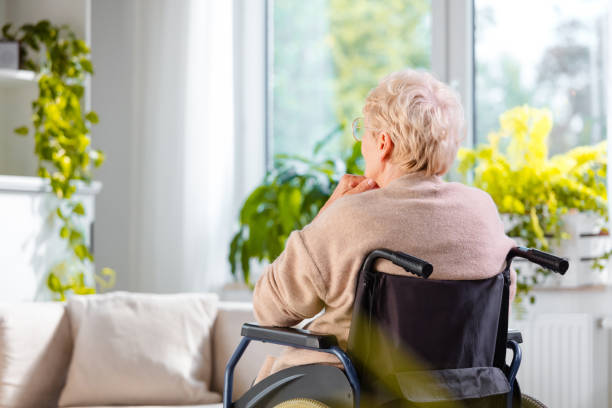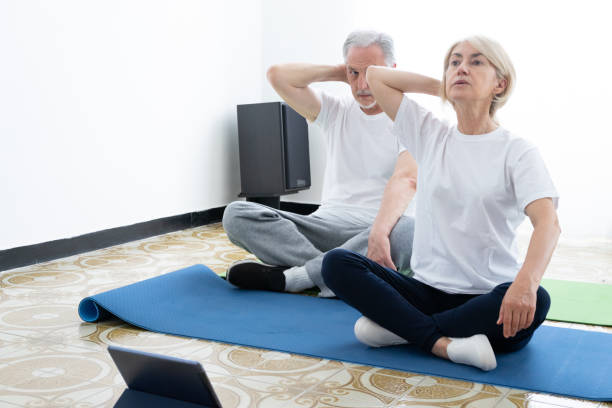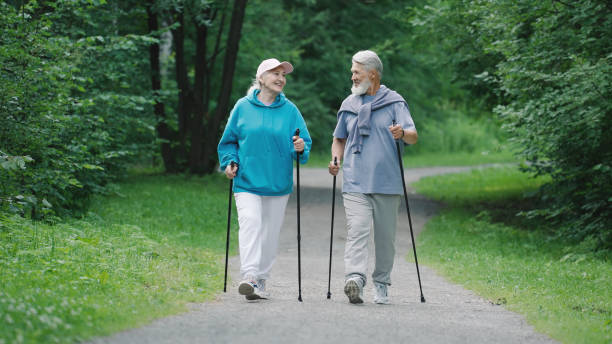Introduction

Physical activity can be a powerful tool in improving mood and reducing depression and anxiety for people with Parkinson's. Research has shown that physical activity can positively affect an individual's mental health, including improved self-esteem, reduced stress levels, improved sleep quality, and overall well-being.
In this blog post, we'll discuss how physical activity can help Parkinson's patients cope with their symptoms and the best ways to incorporate physical activity into their daily routines. We'll also discuss how to find support and resources for those who need it.
Effectiveness of physical activity on patients with depression and Parkinson's disease: A systematic review
Physical activity has long been key to maintaining physical and mental health. In Parkinson's disease, research has suggested that physical activity can play an important role in reducing depression and anxiety while improving overall mood.
This systematic review examines the literature on physical activity interventions for patients with depression and Parkinson's disease. The primary objective was to determine the effectiveness of physical activity interventions in improving mood and reducing depression and anxiety in patients with Parkinson's disease.
We searched several electronic databases, such as MEDLINE, CINAHL, and PsycINFO, to find articles published from 1990 to 2019.
In all, 14 studies met the inclusion criteria, eight of which were randomized controlled trials. The data from the included studies indicated that physical activity interventions could effectively improve mood and reduce depression and anxiety in patients with Parkinson's disease.
Overall, the results suggest that physical activity may be a valuable intervention for individuals with Parkinson's disease who experience depression or anxiety. Future research should focus on investigating the impact of physical activity on more specific outcome measures, such as quality of life. Additionally, larger and longer-term studies are needed to examine the potential benefits of physical activity for patients with Parkinson's disease and depression.
Types of Exercise for Improved Mental Health in Parkinson's Patients

Physical activity can improve mood and reduce depression and anxiety in Parkinson's patients. Regular exercise can improve strength, coordination, flexibility, and balance.
The types of exercise most beneficial for those with Parkinson's include aerobic activities such as walking or biking; strength training; balance exercises; and range of motion activities such as yoga or tai chi.
Aerobic exercise improves mood and can help increase energy levels, improve cardiovascular health, and reduce depression symptoms. Walking is an easy and convenient aerobic activity that can be done anywhere. Biking is another good option for those who need more of a challenge since it requires more coordination.
Strength training is important for people with Parkinson's because it can help slow the disease's progression and improve overall strength and balance. This exercise should focus on different muscle groups like legs, arms, and core muscles. Examples of strength training exercises include lifting weights or using resistance bands.
Balance exercises can help to prevent falls and improve coordination. This exercise should involve the whole body and may include the following:
-
Standing on one leg.
-
Walking in a straight line.
-
Stepping up and down from a step stool.
Range of motion exercises such as yoga or tai chi can increase flexibility and improve balance. These activities involve slow, controlled movements and can be adapted to accommodate any mobility issues.
Exercising regularly is important for overall health, but it can also positively affect mental health in those with Parkinson's disease. With the right type of exercise, people with Parkinson's can experience improved mood, better sleep, and lower levels of depression and anxiety. So, consult a healthcare professional to determine which type of exercise best suits your needs.
Benefits of Physical Activity for Mood Improvement in Parkinson's Patients
Physical activity has many benefits for people with Parkinson's, including improved ability to perform activities of daily living, increased endurance and strength, and improved gait. But physical activity also positively affects mood, helping reduce depression and anxiety in individuals with Parkinson's disease.
Exercising helps release endorphins—chemicals that improve your mood and make you feel better. Endorphins can help reduce depression and anxiety, helping patients with Parkinson's better manage the symptoms associated with their disease.
Exercise also helps to improve sleep quality, which is essential for a healthy lifestyle. When individuals get good restful sleep, it helps to lift their mood and reduce feelings of depression. Exercise has the potential to lower stress and boost energy, which can be advantageous for mental well-being.
Finally, engaging in physical activity can help Parkinson's patients socialize with other people with the disease. This connection with a community of people can provide emotional support and a sense of belonging, which can help to improve overall mood and reduce feelings of depression.
Some Examples of appropriate exercises for PD Patients
Here are ten examples of physical activities that are safe and beneficial for individuals with Parkinson's disease:
1. Swimming:
Swimming is a great physical activity for individuals with Parkinson's disease patients. It is low-impact, can help improve flexibility, and reduce joint pain and stiffness associated with PD. Additionally, the resistance from the water helps increase strength without adding additional stress on joints or muscles. Swimming can also be beneficial for mood regulation, as the calming effect of the water can help reduce depression and anxiety.
2. Walking/Jogging:

Walking and jogging are excellent physical activities for PD patients, as they help improve flexibility, strength, coordination, balance, and posture. Additionally, these activities can be done outdoors while social distancing. Regular walking or jogging can also help to reduce depression and anxiety in those with PD by providing a sense of accomplishment and improving self-esteem.
3. Stretching:
Stretching is an important physical activity for PD patients as it helps improve flexibility, increases range of motion, and can reduce stiffness associated with the disease. Additionally, stretching allows for a mindful moment that can help to regulate mood and reduce anxiety or stress.
4. Yoga:
Yoga is an excellent physical activity for PD patients, combining stretching, strength-building, and mindfulness. Additionally, combining these different elements can help improve flexibility, coordination, and balance while providing mental benefits like reducing depression and anxiety.
5. Tai Chi:
Tai chi is another great physical activity for PD patients, combining mindfulness and physical movement. The mindful elements help to improve coordination and balance, while the low-impact movements help to reduce joint pain and stiffness. Additionally, tai chi can benefit mood regulation by helping reduce depression and anxiety.
6. Balance Exercises:
Balance exercises are very important for those with PD, as they help improve coordination and reduce the risk of falls. Balance exercises can also help reduce stiffness associated with the disease and improve posture.
7. Core Strengthening Exercises:
Core strengthening exercises are important for individuals with PD as they help to improve posture, balance, and coordination. Additionally, core exercises can help reduce the risk of falls and increase strength and endurance.
8. Resistance Training:
Resistance training is another great physical activity for those with PD, as it helps to build muscle strength and endurance. Additionally, resistance training can improve coordination, balance, and posture while providing mental benefits like reducing depression and anxiety.
What type of exercise is best for depression?
Individualized exercise is the most effective for depression. Low-impact exercises such as walking, swimming, and biking are good starting points for people with Parkinson's. Other activities such as tai chi, yoga, and stretching can also help alleviate symptoms of depression and anxiety. Additionally, engaging in social activities can provide a sense of community and connection, which often helps to reduce depression.
Physical activity can also help boost mood by increasing endorphins, or 'happy hormones' in the body. Endorphins are released during physical activity and help reduce the effects of stress hormones such as cortisol and adrenaline. Studies have shown that regular exercise can effectively treat mild to moderate depression and anxiety in Parkinson's patients.
Beyond its mental health benefits, physical activity is also essential for maintaining balance and coordination and reducing fatigue that can come with the disease. Additionally, exercise helps to maintain strength and flexibility, which can help keep mobility issues at bay. It is important to note that exercise should always be done with appropriate support to ensure safety and comfort.
Exercising regularly not only helps reduce depression and anxiety in Parkinson's patients, but it can also help improve overall well-being and quality of life. Additionally, the positive effects of physical activity can have long-term benefits for people living with the disease. By engaging in regular exercise, Parkinson's patients can experience improvements in their mood, energy levels, and physical health.
FAQ's
How does physical activity reduce stress and anxiety?
Physical activity releases endorphins, chemicals that reduce stress and boost your mood. Regular physical activity can provide a sense of accomplishment and increase self-esteem, which can help reduce symptoms of anxiety and depression disorders in people with Parkinson disease.
Does exercise increase dopamine in Parkinson's?
Studies have indicated that Parkinson's patients can experience increased dopamine levels through exercise. Dopamine is a neurotransmitter that helps to regulate movement and mood, so an increase in dopamine could help improve motor control and reduce depression and anxiety. Additionally, exercise can improve overall well-being by helping reduce fatigue associated with the disease.
How does exercise work for depression mechanisms of action?
Exercise works for depression by releasing endorphins, hormones that act as natural antidepressants. Endorphins help to reduce stress hormones and promote feelings of happiness. Furthermore, engaging in physical activity can boost one's sense of achievement and enhance self-confidence, resulting in improved emotional well-being and decreased susceptibility to depression.
Does physical activity improve mood?
Yes, physical activity can improve mood by releasing endorphins, hormones that act as natural antidepressants. Exercise can also boost self-esteem and give a sense of achievement, which can ultimately help reduce feelings of depression. Studies have shown that regular exercise can effectively treat mild to moderate depression in Parkinson's patients.
Overall, physical activity can benefit Parkinson's patients regarding physical and mental health.
How might physical activity benefit patients with Parkinson's disease?
Regular physical activity can benefit Parkinson's patients in several ways. Physical activity can help reduce depression and anxiety, improve balance and coordination, maintain strength and flexibility, and reduce fatigue associated with the disease. Regular exercise can also help increase dopamine levels, which is important for motor control.
Conclusion
In conclusion, physical activity can effectively treat mild to moderate depression and anxiety in Parkinson's patients. Regular exercise can help reduce stress hormones, improve balance and coordination, maintain strength and flexibility, and increase dopamine levels which is important for motor control.
Furthermore, regular physical activity also provides a sense of accomplishment and increases self-esteem, which can help improve overall well-being. Therefore, patients and caregivers should discuss incorporating physical activity into the treatment plan with their doctor to ensure the best possible outcome.

